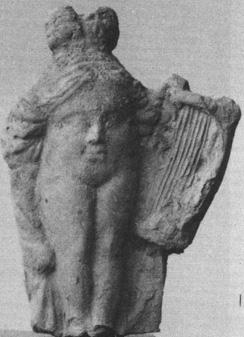
Baubo
In his wandering race in search of his daughter, it is in the village Elevsin inconsolable Demeter , turned into an old woman, breaks her mourning with laughter. A double tradition tells of how obscene words and gestures entertained and consoled the holy mother.
В Homeric anthem Demeter (192-211) kind Yambe encourages the goddess with rude jokes. The poet does not say anything about the content of these obscene words, but the effectiveness of the words Yambe is sure. Indeed, Demeter laughs, interrupts her mourning and stops fasting, agreeing to drink cookeon (a drink made of flour, water and coins) offered to him by Metanir, the wife and mistress of Keleos.
The Baubo of the Church Fathers plays a role comparable to that of Yambe. But where Yamba manages to appease the goddess by throwing incongruous remarks to her, Baubo fails with his speech to convince Demeter to abandon her maternal mourning. Then Baubo changes his image and begins to act: surprising Demeter, she offers him a stunning sight by folding her peplos. This shameless exposure ( anasurma ) caused a laugh deceased mother who agrees to drink cookie, proposed to her by Baubo. Christian polemicists who ascribe a description of an obscene gesture to the Orgics hold two versions of this ridiculous scene. Clement Alexandrian ( Protrepticus ,II, XX , 1-XXI , 2), followed by Eusebius of Caesarea ( Evangelical Preparation ,II, III , 31-35), tells that young Iacchus was under Baubo's rolled-up clothes, laughing and waving his hand. While Arnobe ( faced with nationes, V, 25-26) presents a different and more detailed version in which Baubo's exposed sex takes, through cosmetic surgery, the appearance of a child's figure.
This is a "spectacle" ( théama, spectacle ), marking the end of Demeter's mourning, has given rise to many interpretations. Usually historians saw in him an etiological myth justifying fertility rites; and some specialists wanted to recognize in Baubo the mythical memory of the manipulation of sexual objects in Eleusis.
The figurines were found at the beginning XX - th century in the temple of Demeter and Cora (~ IV е s.) In Priene (under the editorship of T. Wiegand and G. Schroeder, Berlin, 1904) baubo were identified. Terracotta figurines represent a disproportionate head, placed without intermediaries on a pair of legs. In the center of this atrophied body is a still full face, with a nose and two eyes at chest level. Under the mouth is a female sign. Thick hairs surround these pubic figures of impossible anatomy. Priene's "Baubô" confuse head, belly and female.
Baubo, whose name evokes the gesture and murmur of lullaby nurses (Empédocle, Diels, fragm. 153), is also indifferently identified with the various categories of female representations - magical, mythical, or ritual. Generally speaking, therefore, Baubo was associated, often confused, with everything related to "aishrology" in the ancient world, in particular, with obscene words and objects that reminded of the feminine.
Leave a Reply